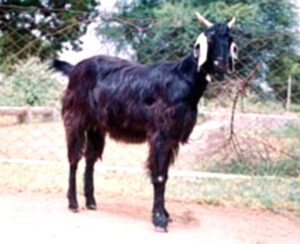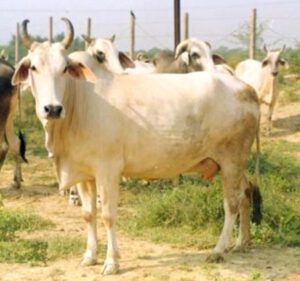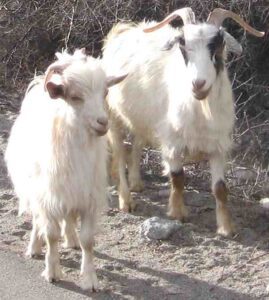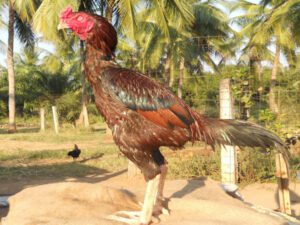Asil chicken (also spelled Aseel or Asli) is an ancient breed of chicken from India. They are originally kept for cockfighting, but nowadays these birds are also kept for ornamental purposes. They are gaining popularity throughout the world rapidly.
Asil chickens were brought to Europe around 1750. They are considered as the strongest game bird in the world. They are very smart, strongly muscled and they contributed to the modern Cornish (broiler) breed.
Sometimes Asil chickens are friendly when they are kept apart from other roosters. But you should not keep many roosters together, because they will fight until death. Hens can sometimes be kept together but have to be watched closely in case of fighting. They are friendly, very tame and trusting towards humans.
Asil chicken breed entered the American Poultry Association’s Standard of Perfection in 1981. Asil hens are not among the good layers, but they are excellent sitters and mothers.
Popularity of this chicken is increasing gradually throughout the world. It is mainly popular as pets, but also popular as show bird and also used for exhibition purpose. It is a very old breed and was very popular for cockfighting in the past.
Asil chickens have compact, and extremely muscular body which is held in a distinctive upright position. And they are much heavier than they appear. They are so pugnacious that the hens will often fight each other for hours.
Even the little chicks have been seen sparing each other and chicks of other breeds (sometimes to the point of wounding them). However, read origin, physical characteristics, behavior, varieties, uses and other information related to this breed below.
Origin and History
Asil is a beautiful chicken that has a long and interesting history. The breed is believed to have originated in India, specifically in the region of Punjab. It is thought to be one of the oldest chicken breeds in the world, with a history that can be traced back several thousand years.
This chicken breed was developed for its fighting ability and was bred to be strong, aggressive, and fierce. The breed was highly valued by the Indian aristocracy for its fighting prowess and was often used in ceremonial fights and other events. They were also used for meat and eggs, but their primary value was as a fighting bird.
Characteristics
Asil chickens have wide and very beautiful chest. Their body structure is very good and they become very strong. Legs and neck of these chickens are very long compared to other common chicken breeds.
Both roosters and hens have short and hard feathers which are held tightly to their body. They have a meaty carcass and they are especially noted for having a large heart as compared to their body size. They also have short intestines as compared to some other common chicken breeds.
There are many varieties of Asil chickens are available. Depending on the variety, the color of feathers can be black, red or mixed. They have a small pea comb. Most of the Asil varieties are big in size and very hardy. Diseases are pretty less.

Size
On an average an adult Asil rooster weights about 3kg – 4kg, and an adult hen can weight about 2.5kg – 3kg.
Temperament
Asil chickens are known for their aggressive temperament. That’s why they have been bred for fighting purposes for centuries. They are highly territorial and can be fiercely protective of their owners. However, they are also known to be loyal and affectionate with their owners, and can form strong bonds with them.
Behavior
Asil hens are seasonal layers and lay a few eggs. But they are excellent mothers. Hens become broody and make excellent sitters and protective mothers. Asil chicks take more time to be mature and they will often fight with other chicks from a very early age. So, it will be wise to keep them separate.
Otherwise they will fight to the death if given the chance. Asil chickens require more space to grow perfectly compared to other chicken breeds. Despite being a fighting bird, these birds are very friendly towards humans and can be tamed very easily. These chickens do not do well in a cold climate and they usually prefer dry conditions..
Housing Requirements
When it comes to their housing requirement, there are several key factors to consider, including their size, temperament, and need for protection from the elements.
Asil chickens are larger than many other breeds of chicken, and they need plenty of space to move around and exercise. They also require a high level of security, as they are highly territorial and can become aggressive if they feel threatened. You should keep your Asil chickens in a secure coop or pen, and ensure at least 6-8 square feet space per bird.
Install good ventilation system and try to provide some good bedding materials. And don’t forget to clean the house on a regular basis.
Dietary Requirements
Feeding the Asil chickens properly is the most important part of their care. Good food helps to maintain their good health. They have unique dietary needs that differ from other breeds of chickens. And it is important to understand these needs in order to keep them healthy:
Their food should contain at least 18-20% protein. You can also supplement their diet with high protein foods such as soybeans, mealworms, and crickets.
These chickens also need a variety of vitamins and minerals for staying healthy. A balanced diet is recommended for them that includes a variety of fresh fruits and vegetables, as well as a mineral supplement. You can also provide your chickens with access to a grit supplement, which helps them digest their food properly.
Along with good and nutritious food, fresh and clean water is essential for Asil chickens. They need access to water at all times. And try to change their water frequently to prevent the build-up of bacteria and other harmful substances.
Reproduction/Breeding
Like many other breeds, the Asil chickens are naturally very good breeders. They will breed easily if you keep a good ratio of hens and roosters in your flock.
Caring
Taking good care of these chickens is very important. Asil is a very strong and hardy chicken breed and it requires special caring. Try to provide them with a good shelter, feed them nutritious food, and monitor their health on a regular basis.
Uses
Asil chickens were used for cockfighting purpose in the ancient time. But now they are raised mainly as pets or as a hobby or just for ornamental purpose. They are valued for their ornamental beauty, flavorful meat and unique genetics. These chickens are very good for very high quality meat production (although, their growth rate is very slow).
Eggs production
The Asil hens are not among the very good layers, but they sit well. Generally, a hen lay about 70 eggs per year.
Popularity and Price
Asil is a very popular chicken breed in many countries around the world. Today, they are raised mainly as pets or as a hobby or just for ornamental purpose.
Exact price of these chickens may vary from place to place. But these birds are generally sold for $10 to $100. And price of the exhibition rooster can go up to few hundred dollars. A good English fighter rooster may cost anywhere from $50 to $100, whereas the price of a show or exhibition rooster may go up to $800.
Lifespan
Average lifespan of an Asil chicken is around 10 years.
Cultural and Historical Significance
Asil chickens have a long and rich history, and they are an important cultural symbol in many parts of the world. They have been used in many traditional cultural events, religious ceremonies, and even in certain types of artwork. In some regions, these chickens are considered to be a national treasure and are protected by law.
| Breed Name | Asil |
| Other Name | Also spelled as Aseel or Asli |
| Breed Purpose | Ornamental |
| Breed Temperament | Aggressive, Friendly Towards Humans, Bears Confinement well, Easily Handled, Quite, Docile, Hens are Very Good and Protective Mothers |
| Breed Size | Large Fowl |
| Broodiness | Frequent |
| Comb | Pea Comb |
| Climate Tolerance | All Climates |
| Egg Color | Light Brown |
| Egg Size | Medium |
| Egg Productivity | Very Low |
| Feathered Legs | No |
| Rarity | Pure Breed Asil Chickens are Rare |
| Varieties | Black, Black Breasted Red, Blue Breasted Red, Dark, Duckwing, Spangled and White |
| Country of Origin | India |
Pros and Cons
Like many other chicken breeds, Asil Chickens also have some pros and cons. Here are some pros and cons of this breed:
Pros
- Beautiful game birds
- Very friendly towards humans
- Hens are good sitters and excellent protective mothers
- Very intelligent
- Very hardy
- Roosters are very strong and protect the hens
Cons
- Aggressive
- Will fight to death when many hens or roosters are kept together
- Generally take long time to be mature
- Asil hens are not good layers
Is Asil Chicken Good for You?
Yes, Asil chickens are good for you if you…….
- Want to have some beautiful birds.
- Are willing to raise some game birds.
- Want to have a few chickens as pets.
- Are looking for some intelligent and hardy chickens.
- Need some chickens which are friendly towards humans.
- Are looking for some protective mothers who can take care of the chicks perfectly.
- Want to enhance the beauty of your backyard by keeping some beautiful chickens.





